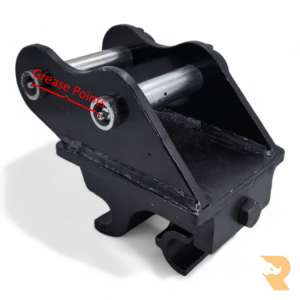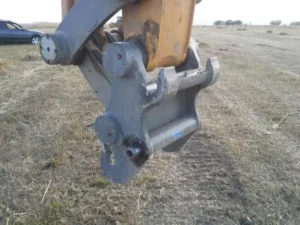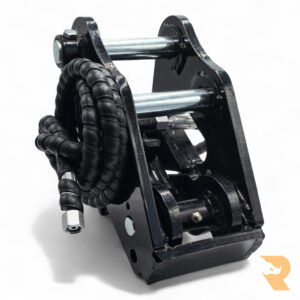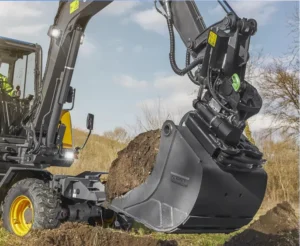Don’t Get Hitched with the Wrong Hitch: Picking the Right Coupler for Your Mini Digger
A quick coupler can be thought of as a connector or adapter. Placed on the end of the excavator’s stick, it streamlines the process of changing between different attachments by eliminating the need to remove pin shafts and sleeves with each change manually. Use it with your buckets, hammers, rippers, crushers, hydraulic shears, and much more to improve your machine’s productivity and versatility. Quick hitches (or couplers) might not be the sexiest part of your mini excavator — but get the wrong one, and suddenly you’re spending more and more time swapping buckets than digging dirt.
The four main types of quick hitches are manual/mechanical hitches, autolocking hitches, standard hydraulic hitches and hydraulic rotating tilting hitches. They all have pros and cons, and this article will help you decide which one is best for your situation.
Mechanical / Manual Quick Hitch
The mechanical quick hitches are simple, cheap, and old-school. This hitch requires you to exit the cab twice to change tools. The first time, you must release the locking pin or lever to disengage the current attachment and allow it to drop safely. Then you have to use the mini excavator to align the quick hitch with the new attachment. After exiting the cab again, you have to insert and secure the locking pin or lever to lock the new attachment into place. These are perfect if you only rarely change attachments or if you are a non-professional user looking to stay on a tight budget.
Autolock
An autolock quick hitch is a more pricey option that cuts down the change time by requiring you to exit the cabin only once. With this hitch, the operator needs to get out of the cab to set the hitch to an open position to drop the original attachment. Afterwards, once you align the hitch with the new attachment, the pressure-sensitive finger inside will cause the latch to snap shut and secure your attachment. This is a great option if you change attachments frequently or if are a professional looking to increase efficiency.
Another key advantage is that they can tolerate a slightly larger range in pin diameter and spacing compared to mechanical quick hitches, due to the clamping mechanism and the travelling or safety latch that ensures secondary retention. This can allow you to mix and match buckets and attachments between different excavators if within the ranges specified by the quick hitch manufacturer.
Autolock quick hitches are not to be confused with semi-automatic quick hitches. When using a semi-automatic quick hitch, the safety system (usually a safety pin) must first be removed each time the attachment is changed. It must then be re-inserted after the new attachment has been engaged. This is a safety concern because the safety pin can be left out, and semi-automatic quick hitches are banned in many workplaces, and their use is heavily restricted in countries such as the United Kingdom and Australia.
Standard Hydraulic Quick Hitch
Another option for increasing efficiency in switching attachments is the hydraulic quick hitch. They connect to your excavator’s hydraulic lines, allowing you to power the internal hitch spring via a switch. Cab-controlled, fast, slick. Your excavator gets a lazy luxury upgrade — no more climbing out mid-job, saving time (and knees).
This is not only an efficiency advantage, but also a safety advantage for a lot of work sites, with the operator being able to stay within the cab. They also retain the increased range of pin and spacing that automatic hitches have over mechanical hitches.
But this doesns’t come without a cost. Not only are they more costly, they are also more difficult to install as the hydraulic lines have to be inserted into the excavator. If you don’t have the required knowledge, you may need to hire an external service to help you install the hitch, which will cost more money and time. However, this is usually worth it if you are a professional who uses an array of different attachments.
Rotating Tilting Hydraulic Quick Hitch (Tiltrotator)
Note that you can also get hitches that just tilts without rotating. This is the most expensive hitch type, modifying the standard hydraulic hitch. Rotates, tilts, practically moonwalks. They are incredibly flexible but are they right for you?
The rotating tilting mechanism doesn’t come without drawbacks. Due to the increased height of the hitch, there is a decrease in breakout force, the amount of force transferred through the attachment and into the ground, making it potentially slower or more difficult to do jobs like digging tough surfaces. This means the standard hydraulic quick coupler may not just be cheaper, but also better if you don’t require the tilting function.
The rotating tilting quick hitch is a good fit for people who need to make clean surface finishes such as landscaping contours, sloped surfaces, creating cambers on roads, and profiling the edges of drainage trenches. They can also help with backfilling against retaining walls or batters and working around obstacles or in hard to reach areas. With attachments such as a bucket and thumb combo, or pallet forks, this hitch can also help your excavator work for construction tasks without needing to reposition the excavator as often.
Concluding Thoughts
The right hitch = less drama, more digging. The wrong hitch = wasted time, frustrated operators. The right quick hitch can boost productivity, safety, and versatility. Consider your budget and your needs as quick hitches are not one size fits all, and a higher cost does not necessarily mean a better performance for your usage. If you are interested in checking out our quick hitches, you can find them here.




